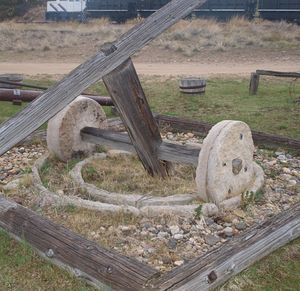Arrastras

An arrastra, also known as a Mexican Rastra, was a primitive method used by early miners to process gold and silver ores. It was introduced to the new world by the Spanish in the 1500ís. They were used throughout the world, often at remote locations where other processing methods were not feasible. Itís simple yet effective design made it a valuable tool for the early prospectors to process ore on location, without having to transport tons of material to a stamp mill.
Arrastras were designed to extract the valuable gold or silver that was locked in host material. Unlike placer mining, gold that is mined from lode sources require crushing to extract the gold from rock. The basic design generally used two large flat stones that were dragged around a circular pit made from flat stones. The drag stones were attached to a central pivot which allowed them to be dragged repeatedly over the ore that was placed in the arrastra.
They were typically powered by horses or mules, although some were powered by waterwheels and even steam engines in later years. The ore was placed in the arrastra, generally a few hundred pounds at a time.
Since each one was built on location, they were each somewhat unique in size and construction, although the basic designs were all more or less the same. The ore would be pulverized under the large stones until it was broken down to a coarse dust that could be further processed by the miners.
It generally took several hours to grind the ore sufficiently for further processing. When it got ground down to near completion, an appropriate amount of quicksilver was added with the fine gold that had been released. The grinding process would continue, allowing the mercury and gold to amalgamate. When the process was nearing completion, several buckets of water were added to the arrastra, suspending the lighter material that was then bailed out, leaving just the small amounts of amalgamated gold at the bottom of the arrastra. Several hundred pounds of ore are then placed in the arrastra and the process was repeated.
After running material for several weeks the grinding process would be stopped and the amalgam would be collected from the cracks in the bottom of the arrastra, then it would be carefully panned and retorted to extract the gold.
Additional Reading about Historic Mining Methods:
Ore Crushing Stamp Mills
Hydraulic Mining
Bucket Line Dredging
Evidence of Historic Mining
Arrastras were designed to extract the valuable gold or silver that was locked in host material. Unlike placer mining, gold that is mined from lode sources require crushing to extract the gold from rock. The basic design generally used two large flat stones that were dragged around a circular pit made from flat stones. The drag stones were attached to a central pivot which allowed them to be dragged repeatedly over the ore that was placed in the arrastra.
They were typically powered by horses or mules, although some were powered by waterwheels and even steam engines in later years. The ore was placed in the arrastra, generally a few hundred pounds at a time.
Since each one was built on location, they were each somewhat unique in size and construction, although the basic designs were all more or less the same. The ore would be pulverized under the large stones until it was broken down to a coarse dust that could be further processed by the miners.
It generally took several hours to grind the ore sufficiently for further processing. When it got ground down to near completion, an appropriate amount of quicksilver was added with the fine gold that had been released. The grinding process would continue, allowing the mercury and gold to amalgamate. When the process was nearing completion, several buckets of water were added to the arrastra, suspending the lighter material that was then bailed out, leaving just the small amounts of amalgamated gold at the bottom of the arrastra. Several hundred pounds of ore are then placed in the arrastra and the process was repeated.
After running material for several weeks the grinding process would be stopped and the amalgam would be collected from the cracks in the bottom of the arrastra, then it would be carefully panned and retorted to extract the gold.
Additional Reading about Historic Mining Methods:
Ore Crushing Stamp Mills
Hydraulic Mining
Bucket Line Dredging
Evidence of Historic Mining
Highly Recommended Prospecting Books on Amazon:

The Gold Prospector's Field Guide:
A Modern Miner's Handbook for Successfully Finding Gold

Metal Detecting Gold Nuggets:
The Essential Guide to Finding Gold with a Metal Detector
